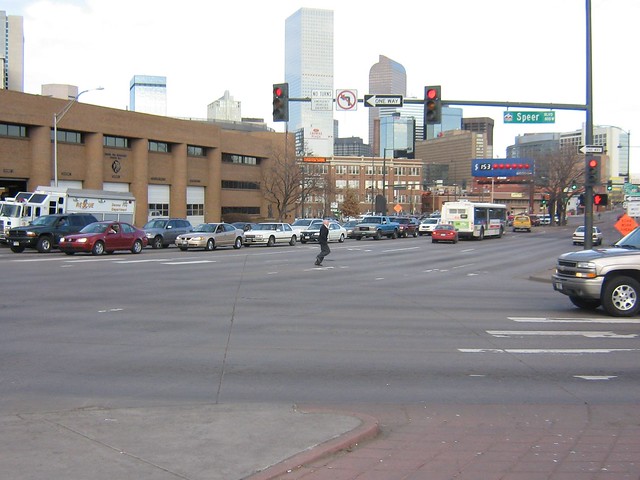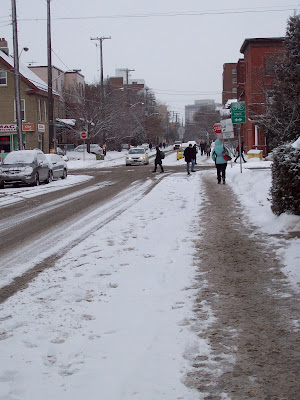Today’s post, discusses the implications of neighbourhood safety, which was briefly touched on in the previous post on aesthetics. I should highlight here that when I refer to safety, I am including both objective (measured, say with crime or traffic accident statistics) and subjective forms (as perceived by residents themselves).
In order for communities (neighbourhoods or whatever synonym you would like to use) to be sustainable, they should not be environments in which residents are unable to experience all that the community has to offer, either because they live in fear of getting injured or killed, or are actually more likely to get injured or killed when out and about.
Some studies in the scientific literature have found that unsafe neighbourhoods discourage adult residents from walking – specifically lack of sidewalks (1). This is a huge problem in my neighbourhood where only main arterial roads have sidewalks on each side. Among children, a Canadian study (Nova Scotia) linked increased parental perceived neighbourhood safety to increased participation in unorganized sports (2). Another study in Australia that followed the same children over time (a ‘longitudinal’ or ‘cohort’ study), found that parental concerns with traffic deterred moderate-to-vigorous physical activity among boys, but not girls (3). However, girls' own concerns with road safety was cross-sectionally related to decreased physical activity levels (4).
In terms of obesity, few studies focusing specifically on neighbourhood safety have been conducted. One longitudinal study on children uncovered an influence of parental perceived neighbourhood safety on BMI that appeared to be mediated by increased TV watching. In other words, the results indicate that parents may restrict their children's outdoor physical activity if they perceive the neighbourhood to be unsafe, which translates into increased sedentary behaviours (TV watching in this case) and then increased BMI (5).
 |
| A pedestrian dashes across a huge intersection in Denver (Photo credit: 'Complete Streets') |
In terms of obesity, few studies focusing specifically on neighbourhood safety have been conducted. One longitudinal study on children uncovered an influence of parental perceived neighbourhood safety on BMI that appeared to be mediated by increased TV watching. In other words, the results indicate that parents may restrict their children's outdoor physical activity if they perceive the neighbourhood to be unsafe, which translates into increased sedentary behaviours (TV watching in this case) and then increased BMI (5).
Based on a review by Heath et al, changing urban design and land-use policies may be effective at increasing the physical activity levels of neighbourhood residents (6). The six intervention studies that they reviewed generally centred on redesigning the environment at the street-scale to make walking and biking more enjoyable and safe (examples include improved street lighting, traffic calming, and enhancement of street aesthetics). The median increase in physical activity across the studies was 35% (inter-quartile range of 16% - 62%).
The list below highlights ways communities can potentially increase real or perceived safety. It is a compilation from various sources in the research, public health, and urban planning sectors (1,6-8) . Hopefully more rigorous studies of their effects on residents, in terms of increasing physical activity and decreasing obesity, are soon to come:
○ Traffic calming techniques (to slow down and/or discourage automobile traffic):
· Widening sidewalks and narrowing width of streets
· Adding landscaping – i.e. trees lining the road, placed in between the sidewalk and the road (this can increase perception of safety by pedestrians). At the same time, landscaping should not obscure line of sight by both pedestrian and driver
· Installation of speed humps
· Altering road alignments
· Adding traffic circles or pavement treatments
· Removing vehicular rights of way (i.e. make dead end streets) but keeping pedestrian rights of way
○ Ensuring adequate lighting along roadways and walkways (wherever pedestrians are likely to walk)
○ Ensuring clear way-finding signage for pedestrians
· Pedestrian crossing signs and marked crossing areas
· Street names at the start/end of pedestrian walkways (i.e. ‘catwalks’ in subdivisions)
○ Plowing of bike lanes and sidewalks in the winter time
· This is especially problematic in Canada (see picture below and an interesting post on cycling in the winter by a fellow colleague - in French)
 |
| There is supposed to be a bike lane here - see the green sign? It's hardly ever plowed in the winter (Stewart and Cumberland Streets, Ottawa Canada) |
○ Allowing adequate time for pedestrians to cross at traffic lights
○ Ensuring that at minimum, streets have sidewalks and a paved shoulder for cyclists. Although I'm sure cyclists would much prefer the establishment and maintenance of separate bike trails and more bike lanes on roadways
○ Creating ‘eyes upon the street’
· Layout of residential areas
· Building height and form
Certainly more research is needed on this topic, to relate changes in design, crime levels and overall perceptions of safety to changes in physical activity and obesity. Intuitively though, increasing the level of safety in areas where we live makes our spaces more enjoyable and useful, regardless if they have measurable impacts on our waistlines.
References
- Saelens BE & Handy SL. Built environment correlates of walking: A review. Medicine & Science in Sport Exercise. 2008; 40(7S): S550-66
- Veugelers P et al. Neighbourhood characteristics in relation to diet, physical activity, and overweight of Canadian children. International Journal of Pediatric Obesity. 2008; 3(3): 152-9
- Crawford D et al. The longitudinal influence of home and neighbourhood environments on children's body mass index and physical activity over 5 years: The CLAN Study. International Journal of Pediatric Obesity. 2010; 34: 1177-87
- Carver A et al. Perceptions of neighbourhood safety and physical activity among youth: The CLAN Study. Journal of Physical Activity & Health. 2008; 5(3): 430-44
- Cecil-Karb R & Grogan-Kaylor A. Childhood body mass index in community context: Neighborhood safety, television viewing, and growth trajectories of BMI. Health & Social Work. 2009;34(3):169-77
- Heath GW et al. The effectiveness of urban design and land use and transport policies and practices to increase physical activity: A systematic review. Journal of Physical Activity and Health. 2006; 3 Suppl 1; S55-76
- Institut National de Santé Publique du Québec. Indicateurs géographiques de l'environnement bâti et de l'environnement des services influant sur l'activité physique, l'alimentation et le poids corporel. 2009. Available at: http://www.inspq.qc.ca/pdf/publications/1001_IndGeoEnvBati.pdf
- Dempsey N. Quality of the built environment in urban neighbourhoods. Planning, Practice & Research. 2008; 23 (2): 249-64
Gee, I love your blog!
ReplyDeleteThanks :)
ReplyDelete